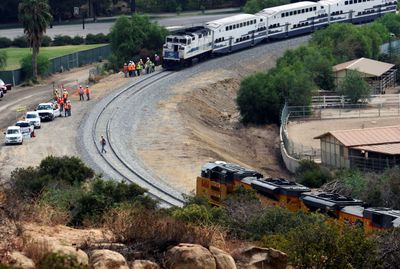Crash reinforces lawmakers’ push for updated rail safety systems
Metrolink urged against plan last year

LOS ANGELES – The head of Metrolink warned Congress a year ago that proposals to require updated safety devices on trains would involve “substantial cost” and urged lawmakers to give railroads “flexibility” in choosing and implementing the new systems.
The testimony came as part of a long-running argument over whether the federal government should require railroads to install safety devices known as positive train controls that can automatically apply the brakes if an engineer misses a stop signal.
Twenty-five people died and 135 were injured in a crash Friday in which a Metrolink commuter train collided with a Union Pacific freight train on a stretch of shared track in Chatsworth. Investigators say the Metrolink engineer went through a signal light that should have warned him to stop until the freight had moved onto a siding.
Political momentum to make the automated safety systems mandatory began to mount Tuesday, with local lawmakers and Democratic Sens. Diane Feinstein and Barbara Boxer, of California, calling for quick action.
“This accident happened because of a resistance in the railroad community in America to utilize existing technology to produce a fail-safe control of trains,” Feinstein said on the Senate floor. “The railroads have resisted, saying these systems are too expensive. Well, how expensive is the loss of human life?”
The Bush administration, in a statement a year ago, strongly opposed mandatory positive train controls, saying the technology “has not yet been proven.” Some experts disagree, however.
Feinstein introduced legislation Tuesday, co-sponsored by Boxer, that would force railroad companies to install the systems by 2012 in high-risk areas where freight and passenger service mix and by 2014 in all other areas, Feinstein spokesman Scott Gerberto said.
Feinstein and Boxer hope to pass the measure before Congress recesses at the end of next week. The system would marry a Global Positioning System with digital communications that would track rail lines’ location and speed, automatically halting trains if they ignored signals. The Federal Railroad Administration estimates that a nationwide system would cost more than $2.3 billion, but some safety experts believe that figure is too high.
Phil LaVelle, a spokesman for Feinstein, said the Boxer-Feinstein bill is stronger than pending House and Senate bills that address positive train control technology because it would mandate the installation of systems in freight and passenger trains and impose stiffer penalties, including $100,000 fines, for companies that fail to comply.
The current House bill would require that only freight trains operating on high-risk corridors be equipped with the system. The Senate bill would mandate further studies but not installation of positive train control.
In response to the earlier bills, the rail industry had raised questions of costs and proposed that companies develop systems on their own timeline.
David Solow, Metrolink’s chief executive officer, urged a Senate subcommittee in July 2007 to provide “as much flexibility in the type of (train control) systems used and their implementation,” saying his agency remained “very concerned about the interoperability” for rail systems such as those in Los Angeles, where freight and commuter lines share tracks.
Solow, through a spokesman, declined to comment Tuesday.